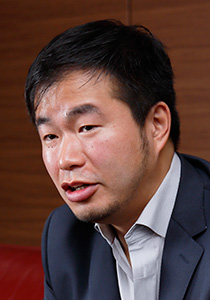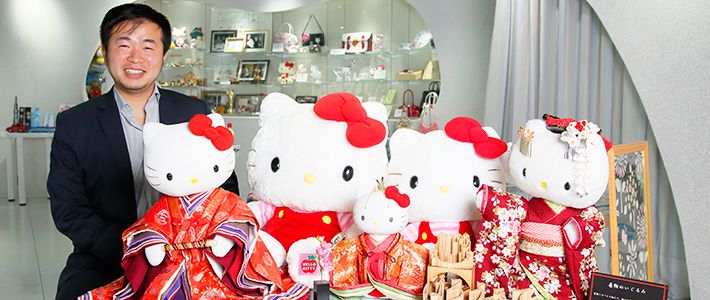
How Hello Kitty Became a Global Superstar: Talking Strategy with Ray Hatoyama
Economy Culture- English
- 日本語
- 简体字
- 繁體字
- Français
- Español
- العربية
- Русский
In 2014, the Hello Kitty brand celebrated its fortieth anniversary. A variety of events have been held worldwide since this fall to observe this landmark occasion for the hugely popular character, originally from Japan but beloved globally.
One such event is the exhibition “Hello! Exploring the Supercute World of Hello Kitty,” which is being held at the Japanese American National Museum in Los Angeles until April 26, 2015. Another related event is Hello Kitty Con 2014, a four-day convention that was also held in Los Angeles from October 30 to November 2, with some 26,000 people in attendance.
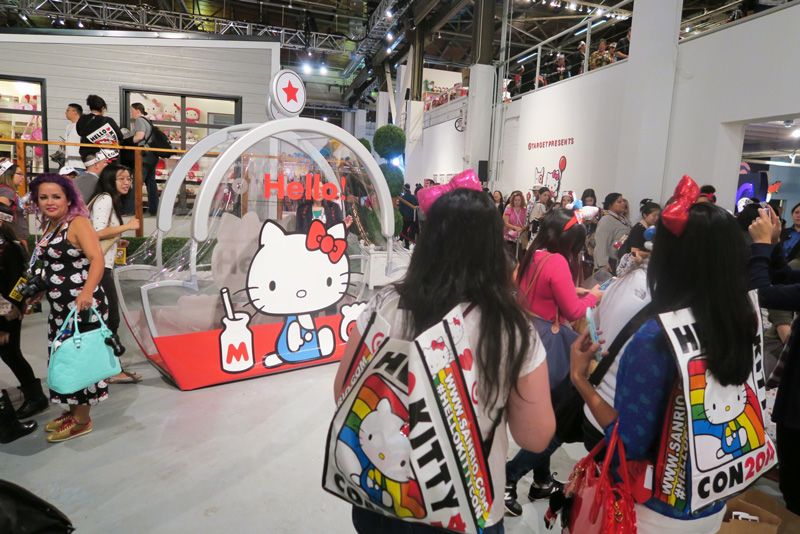 A scene from the Hello Kitty Con 2014 event held in Los Angeles.
A scene from the Hello Kitty Con 2014 event held in Los Angeles.
The popularity of Hello Kitty around the globe has been built on the dramatic expansion of overseas licensing through collaborative initiatives that include tie-ups with jewelry, cosmetic, and apparel brands. One person who contributed to this development is Ray Hatoyama, a managing director at Sanrio—the company that dreamed up the Hello Kitty character. Hatoyama has overseen the development of the Hello Kitty brand in some 130 countries around the world. We asked him to elaborate on some of the factors behind Hello Kitty’s overseas success up to now and to share his view of the future for the character. He began by touching on the worldwide events to mark Hello Kitty’s fortieth anniversary:
“Hello Kitty Con 2014 in the United States was a great success. Katy Perry stopped by unannounced on the first day of the event. Having a celebrity fan of Hello Kitty like Perry show up at the convention made the event even livelier and also generated a lot of media attention.”
Hello Kitty Isn’t a Cat?!
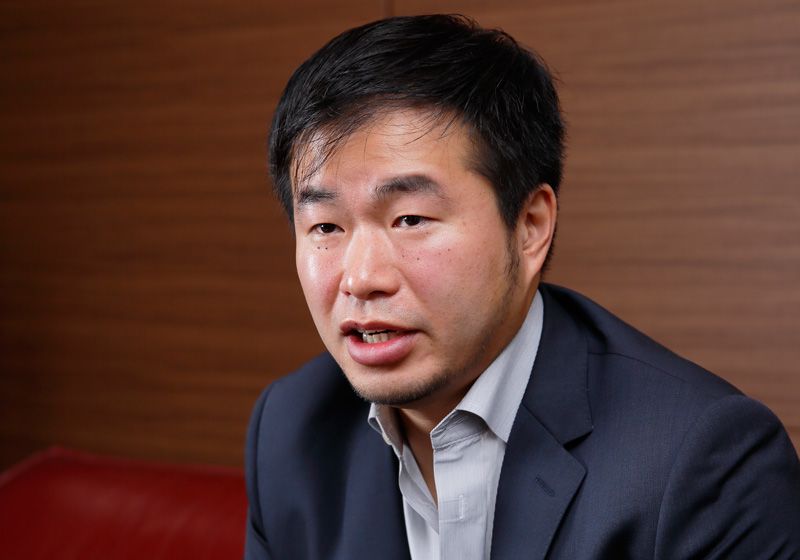 Ray Hatoyama travels the globe for his job, every year spending around 100 days in the United States, Europe, and Japan, respectively, and 60 days traveling around in other countries.
Ray Hatoyama travels the globe for his job, every year spending around 100 days in the United States, Europe, and Japan, respectively, and 60 days traveling around in other countries.
In fact, there are quite a few celebrities who love Hello Kitty, most notably Katy Perry and Lady Gaga. But, as Hatoyama emphasizes, the lucrative market for the character could not have been built solely on the basis of interest among Western celebrities.
Hatoyama notes that the market for Sanrio has changed greatly in the five to six years since he joined the company in 2008. “Prior to that point, the stronghold for Hello Kitty was Japan and Asia. But now Hello Kitty enjoys even a bigger market in Europe alone or the United States alone than in Japan. And there are core fan bases among a wide range of age groups—stretching from customers in their twenties and thirties and older, to teenagers, ‘tweens’ (8 to 12 years old), kids (4 to 7), and toddlers (1 to 3)—each representing its own market. In this way, the Hello Kitty business has been steadily expanding to embrace a very wide spectrum.”
The amazing degree to which Hello Kitty has taken root overseas was revealed in the uproar created among the character’s fans by an August 2014 article in the Los Angeles Times that revealed the shocking news that “Hello Kitty is not a cat.” The misconception that Hello Kitty is a feline stems, obviously, from the character’s name. However, as the article explains, Hello Kitty is in fact a “little girl.” In any case, Hatoyama says, “the ‘controversy’ made us aware once again of just how much attention is paid to the character.”
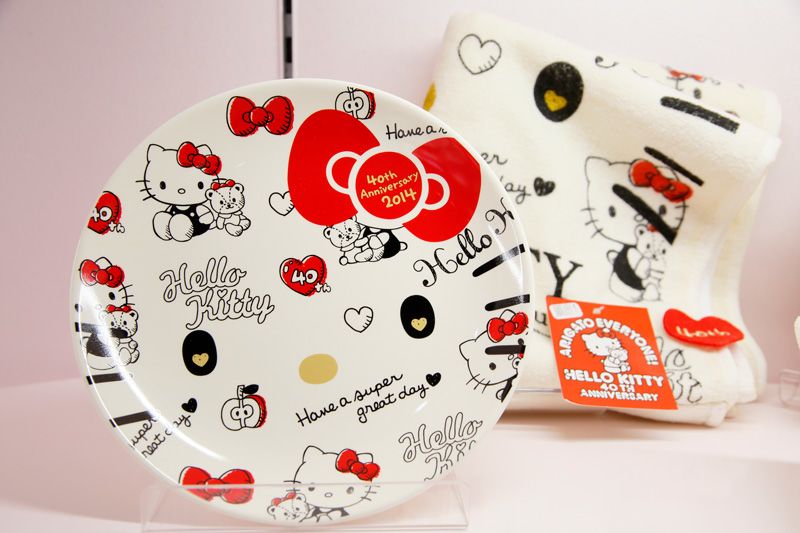 Some of the commemorative goods to mark Hello Kitty’s 40th anniversary.
Some of the commemorative goods to mark Hello Kitty’s 40th anniversary.
Expanding Overseas Sales and Licensing
Hello Kitty first appeared in the United States back in 1976. “From that time through the 1990s,” Hatoyama explains, “the approach taken was to export the Japanese business model, much like the current overseas strategy of Uniqlo, which first set up stores in New York City before then expanding to San Francisco. Starting in the 2000s, we began to develop products in the United States geared specifically to that market.
“In recent years, this move toward localization has progressed further as we have opened up a whole range of distribution channels besides our own Sanrio network. For instance, Hello Kitty products are now available through general merchandise stores, department stores, drugstores, and other retailers in the United States.”
Along with this proactive expansion of distribution networks, collaboration via licensing provision is also being carried out. The licensing business adopts the strategy of synergistic development of the Hello Kitty brand along with other partner brands, as Hatoyama elaborates:
“Some examples of these tie-ups for Hello Kitty goods include our collaboration with Sephora, which is one of the group companies of the French luxury goods conglomerate LVMH; and with Swarovski, an Austria-based producer of jewelry and cut glass. Our approach is to create products through this collaboration that are then distributed by way of our partners’ sales channels.”
Hello Kitty’s Appealing Spirit
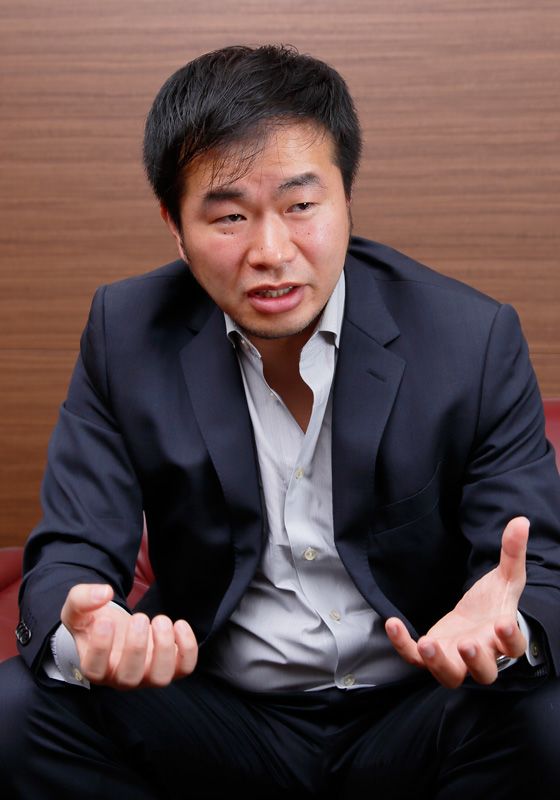 Hatoyama explains how the basis for the Hello Kitty business in the United States dates back to the 1970s.
Hatoyama explains how the basis for the Hello Kitty business in the United States dates back to the 1970s.
Hatoyama has been the driving force behind both of those strategies, based on his realization of the great strength of the Hello Kitty brand.
“Brands like Yahoo, Apple, Coca-Cola, and McDonald’s are characterized by their wide name recognition and the number of people who enjoy their products. It isn’t about providing luxury items. From that perspective, I became keenly aware of how Hello Kitty was establishing itself as a global brand soon after the turn of the century.”
The name recognition of Hello Kitty shot up in the United States around 2005, when a promotional video of Britney Spears featured her wearing Hello Kitty jewelry created by the fashion designer, entrepreneur, and former model Kimora Lee Simmons.
“These efforts reflect our approach of having Americans design products intended for Americans, rather than offering Japanese products,” Hatoyama explains. “We had faced a difficult situation despite our brand power and high name recognition in the United States in that there were cases where the supply of Hello Kitty products did not meet demand, and other cases where the products that were available were not suited to local consumer tastes. We studied those situations and were able to come up with the needed changes.”
“Our first step was to make use of powerful distribution networks, such as those of general merchandise stores or of Toys 'R' Us, in order to expand our sales channels. It was necessary, for example, to offer a wide array of products, such as party goods for children’s birthdays, gift items, and school-related goods.”
The driving force behind the overseas market expansion has been the core concept of Hello Kitty developed over its 40-year history, centered on the spirit of “Cuteness, Friendship, and Thoughtfulness.” This spirit has struck a chord with people around the world to create a strong brand identity.
“The business initiatives we carried out in the United States from the 1970s to the 1990s in line with that concept formed the basis, I think, for our success in recent years,” Hatoyama suggests.
Designs Best Suited to Each Country
The overseas licensing business for Hello Kitty allows Sanrio’s partners a great degree of discretionary power over design and other aspects:
“It is important for us not to impose our own value judgments on our partners,” Hatoyama says. “There are clear differences when it comes to what product designs Japanese, Americans, or Europeans might prefer. Allowing leeway for those differences in taste makes it possible to come up with the products best suited to a given market, thereby expanding our market presence. We think it is vital to allow each country involved in product licensing to have the freedom to foster its own products.”
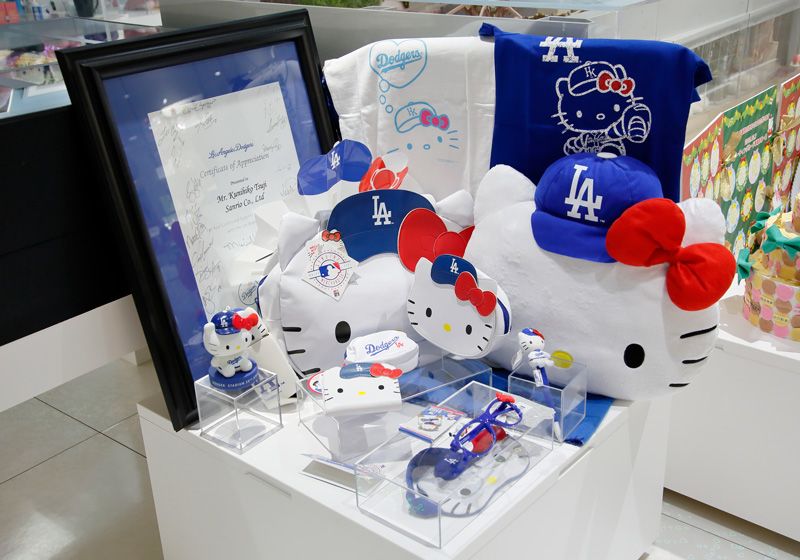 Sanrio entered an agreement with the 30 Major League Baseball teams for licensing of Hello Kitty goods. This photograph shows some of the products created in collaboration with the Los Angeles Dodgers.
Sanrio entered an agreement with the 30 Major League Baseball teams for licensing of Hello Kitty goods. This photograph shows some of the products created in collaboration with the Los Angeles Dodgers.
Hatoyama elaborates on what he considers to be some characteristics of innovative licensed products:
“A lot of the innovative examples come from our collaboration with fashion brands. One particularly innovative brand that we have worked with recently is Undercover, designer Takahashi Jun’s brand. We have undertaken all sorts of very interesting product development, ranging from our collaboration with leading global ‘fast fashion’ brands like Sephora, H&M, Forever21, and Marks & Spencer all the way to our tie-ups with small-scale innovative brands. Since Sanrio does not specialize in fashion, we provide the ‘foundation’ and then let our partners handle the planning and design. And it seems to me that the outcome has been some fantastic products.”
The Road Ahead for Sanrio
Hatoyama frankly notes that the steady progress he made in expanding Hello Kitty business overseas in his first five years at Sanrio benefited from the firm support of the company’s vice president, Tsuji Kunihiko, who passed away suddenly in November 2013.
“Five years ago, Sanrio’s business in Japan was sluggish, so the only prospects for growth seemed to be overseas. Due to the crisis the company faced at the time, it ended up undertaking a lot of challenging new tasks. Vice President Tsuji decisively changed our direction to focus more on the overseas licensing business and gave strong backing to my efforts in that regard.”
We asked Hatoyama about how he would like Sanrio to develop its overseas development in the years ahead, following the death of Tsuji Kunihiko, who had been expected to take over the company from his father Tsuji Shintarō, the founder of Sanrio.
“What will not change, fundamentally, is the Hello Kitty spirit of 'Cuteness, Friendship, and Thoughtfulness,' or the great corporate strength that has emerged from the synergistic benefits of Sanrio’s mission statement, reflected in our slogan: 'Small Gift, Big Smile.' One of our missions in the years ahead, I think, will be to continue to advance the Sanrio brand licensing business globally centered on Hello Kitty."
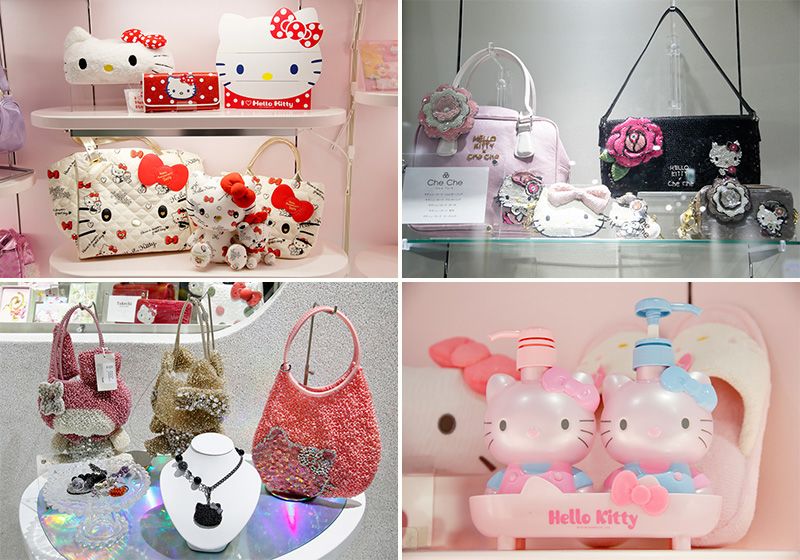 Hello Kitty products run the gamut, from everyday items to luxury goods, offering something to fans of all ages.
Hello Kitty products run the gamut, from everyday items to luxury goods, offering something to fans of all ages.
Different Strategies for Different Markets
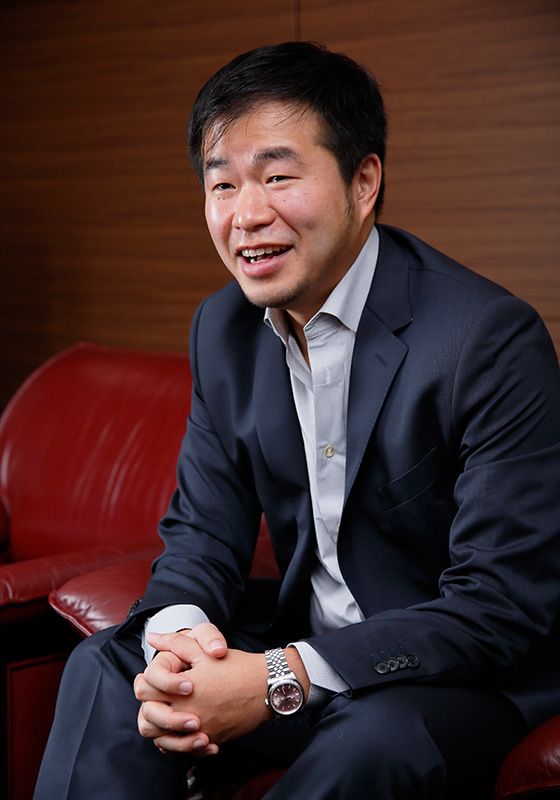 Disney is often cited as a rival to Sanrio; however, Hatoyama thinks Sanrio can come out on top by offering consumers something different than what Disney is offering.
Disney is often cited as a rival to Sanrio; however, Hatoyama thinks Sanrio can come out on top by offering consumers something different than what Disney is offering.
Hatoyama says that a future task for overseas business will be to stabilize the markets that have expanded in leading economic countries, while also opening up markets in developing nations.
“Countries like India and Russia as well as African countries are still developing, and their economies are not yet mature, but they have a market segment of relatively prosperous twenty- and thirty-year-olds. It will take another decade or two before the girls in those countries all have Hello Kitty goods. This means that we need a completely different strategy for these countries compared to our strategy for mature economies, and to consider the medium- to long-term scenario based on that strategy.”
Asia seems to show promise for further growth for Hello Kitty, particularly in China, where a shift is underway from direct product sales to licensing business. South Korea, meanwhile, where Hello Kitty debuted at an early date, is a mature market where Sanrio aims to stabilize prospects over the medium to long term.
“Taiwan is also a mature market,” Hatoyama says, “but there is still plenty of room for Hello Kitty to become a closer part of people’s lives. Recently, the Taiwanese airline company Eva Air teamed up with us to create flights in Hello Kitty designed planes. And there are a lot of other positive examples from Taiwan, where we are involved in providing licensing rights to theme parks as well as a Hello Kitty–themed maternity hospital and a hotel featuring a Hello Kitty guest room. A half-marathon was also held in November of this year to commemorate the birthday of Hello Kitty.”
New Surprises in Store
In advancing a strategy to expand its intellectual property portfolio, Sanrio has purchased the British intellectual property Mr. Men & Little Miss. Hatoyama elaborates on the reasons for this move:
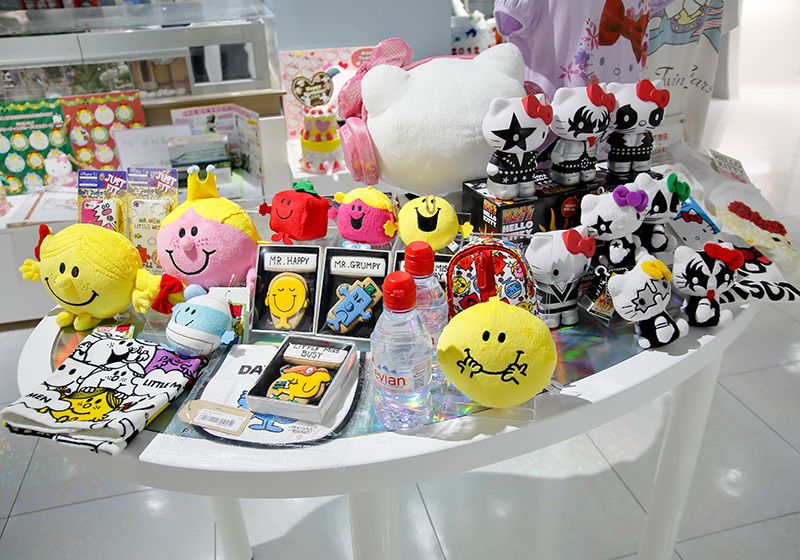 Some “Mr. Men & Little Miss” products alongside Hello Kitty goods.
Some “Mr. Men & Little Miss” products alongside Hello Kitty goods.
“The Mr. Men & Little Miss characters already enjoy great popularity in Europe, particularly in Britain and France. And we want to employ the same licensing strategy with Hello Kitty to expand the characters globally. Our new challenge will be to consider how to foster and expand this IP portfolio.”
At the same time, Sanrio intends to continue undertaking the challenge of trying to come up with new Hello Kitty initiatives that surprise everyone.
One example that Hatoyama points to is the realm of digital content: “Already we scored a huge success for our Hello Kitty stamp on [the Japanese social networking service] Line. I think that we will be able to come up with surprising new developments by expanding that new digital realm, so please keep your eye on that area in the future.”
(Based on a November 2014 interview by staff editor Itakura Kimie held at the head office of Sanrio and originally published in Japanese on December 10, 2014. Photographs © Yamada Shinji.)
Lady Gaga Sanrio Hello Kitty Katy Perry brand licensing Sephora LVMH Swarovski Ray Hatoyama
